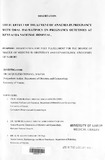| dc.contributor.author | Chesang, Jacqueline | |
| dc.date.accessioned | 2013-05-25T09:34:38Z | |
| dc.date.available | 2013-05-25T09:34:38Z | |
| dc.date.issued | 2011 | |
| dc.identifier.citation | Master of medicine in obstetrics and gynaecology | en |
| dc.identifier.uri | http://erepository.uonbi.ac.ke:8080/xmlui/handle/11295/25638 | |
| dc.description.abstract | Background: Anaemia in pregnancy continues to be a major health problem in most
developing countries, with significant adverse effects for both mother and infant. Iron
deficiency is the main underlying cause for anaemia in pregnancy followed by folate
deficiency. Anaemia has previously been shown to be associated with adverse pregnancy
outcomes. What has not been clearly demonstrated is the effect of treatment of anaemia
in pregnancy with haematinics on pregnancy outcome.
Objective: To determine the effect of treatment of anaemia In pregnancy with oral
haematinics on pregnancy outcome.
Setting: Antenatal clinic, labour ward and antenatal! postnatal wards at the Kenyatta
National Hospital.
Study design: Prospective cohort study.
Methods: Patients were recruited sequentially until the desired sample size was reached.
The exposed were pregnant women with anaemia and the unexposed were non-anaemic
pregnant women matched for age, parity and gestational age with the exposed. The
anaemic pregnant women received Ranferon one capsule twice daily (for treatment) and
the non-anaemic pregnant women received Ranferon one capsule once daily in the third
trimester (as routine supplementation). A full haemogram and peripheral blood film was
done once every four weeks. Both groups were followed until delivery to assess outcome.
Results: Of the 138 participants, 69 were the exposed and 69 unexposed. Among the
exposed, S4 had mild anaemia while IS had moderate anaemia at recruitment. The mean
increase in haemoglobin (Hb) concentration in 4 weeks was 3.3g/dl for the exposed and
1.2g/dl for the unexposed, the difference was highly significant (P<O.OOI). There was
also significant change in the MCV (P=O.OOS) and MCH (P=O.OOS), but no significant
change in MCHC (P=0.S22) and Hct (P=0.42S).The BMI change was minimally less
among the exposed than among the unexposed (0.63Kg/m2 and 0.77 Kg/m2 respectively).
No significant statistical difference in weight gain, BMI change, estimated blood loss at
delivery and temperature at 24 hours post delivery was noted between the exposed and
unexposed. There was a birth weight difference of 48 grams between the exposed and
unexposed, which was not statistically significant (P=0.S2S). No difference in the I and S
minutes Apgar score was noted between the exposed and unexposed. A positive weak
correlation between the birth weight and maternal BMI change was noted in the exposed
and the unexposed arms. Similarly mothers who had a Hb level of ~ 11g/d I after 4 weeks
of treatment delivered babies with a higher birth weight compared to mothers who were
still anaemic. However, a negative weak con-elation was found between Hb change and
birthweight, and Hb change and the Apgar score in the exposed and unexposed arms.
Conclusion: Treatment of mild to moderate anaemia in pregnancy in the third trimester
with oral haematinics results in outcomes similar to those in women without anaemia but
on routine supplementation in terms of haematological, maternal and foetal outcomes.
Recommendation: Anaemia should be aggressively treated with high dose haematinics.
Routine supplementation with oral haematinics of all pregnant women should be
encouraged. | en |
| dc.language.iso | en | en |
| dc.publisher | University Of Nairobi | en |
| dc.title | Effect of treatment of anaemia in pregnancy With oral haematinics on pregnancy outcomes at Kenyatta a national hospital | en |
| dc.type | Thesis | en |
| dc.description.department | a
Department of Psychiatry, University of Nairobi, ; bDepartment of Mental Health, School of Medicine,
Moi University, Eldoret, Kenya | |
| local.publisher | College of Health Sciences | en |

